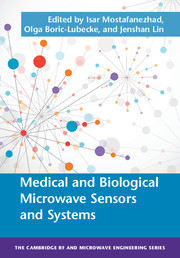Book contents
- Frontmatter
- Contents
- Contributors
- 1 Implantable Wireless Medical Devices for Gastroesophageal Applications
- 2 Embedded Wireless Device for Intracranial Pressure Monitoring
- 3 Wireless Intracranial Pressure Systems for the Assessment of Traumatic Brain Injury
- 4 Microwave Biosensors for Noninvasive Molecular and Cellular Investigations
- 5 Wearable Radar Tag Systems for Physiological Sensing/Monitoring
- 6 Physiological Radar Sensor Chip Development
- 7 Noise- and Interference-Reduction Methods for Microwave Doppler Radar Vital Signs Monitors
- 8 Biomedical Applications of UWB Technology
- Index
- References
8 - Biomedical Applications of UWB Technology
- Frontmatter
- Contents
- Contributors
- 1 Implantable Wireless Medical Devices for Gastroesophageal Applications
- 2 Embedded Wireless Device for Intracranial Pressure Monitoring
- 3 Wireless Intracranial Pressure Systems for the Assessment of Traumatic Brain Injury
- 4 Microwave Biosensors for Noninvasive Molecular and Cellular Investigations
- 5 Wearable Radar Tag Systems for Physiological Sensing/Monitoring
- 6 Physiological Radar Sensor Chip Development
- 7 Noise- and Interference-Reduction Methods for Microwave Doppler Radar Vital Signs Monitors
- 8 Biomedical Applications of UWB Technology
- Index
- References
Summary
Introduction
Interest in ultra-wideband (UWB) technology has increased significantly since the Federal Communications Commission's (FCC's) inquiry in 1998 and approval of its use in 2002. The FCC opened up two bands, the 3.1- to 10.6- and 22- to 29-GHz frequency bands. UWB has been used for both communication and radar applications. The fundamental purpose of this chapter is to open up new areas of application for UWB technologies applied to medicine. This includes pushing the achievable limits in terms of high-accuracy indoor three-dimensional (3D) localization using UWB technology and to use this technology in a real-time location system that tracks multiple tags simultaneously with high 3D accuracy in the millimeter range. The application of this technology goes beyond localization to other areas such as breast cancer detection, human gait analysis, and vital signs monitoring, and the list goes on.
Historically, Time Domain Corporation has pioneered real-time precise location of people and assets. Time Domain is the first company to unleash its full potential [1]. Their pulse-on system enables real-time localization in the most difficult environments – where GPS fails and where ad hoc or moving frames of reference are required. Multispectral Solutions, Inc., also used UWB for multiuser networking applications – more specifically, an ad hoc wireless UWB communications network for tactical voice and high-speed communications, a long-range UWB system for over-the-water and non-line-of-sight voice, data, and video communications, and a wireless UWB communications network for support of both tactical and strategic (long-haul) communications [2].
In this chapter, we will focus on three areas: (1) indoor positioning, (2) human gait analysis and vital signs detection, and (3) early breast cancer detection.
Overview of UWB Technology for Indoor Positioning Systems
It is important to recognize that the use of UWB technology in a high-performance localization system requiring millimeter 3D accuracy has not been well researched, and far fewer systems have been developed compared with its use in cheaper but more widespread systems with lower accuracy requirements on the order of 10- to 15-cm 3D accuracy.
These localization systems based on using UWB narrow pulses are typically comprised of a transmitter and numerous receivers. The transmitter (the tag) has a narrow-pulse generator (in the picosecond range) controlled by a clock, a power amplifier, and a wide-band omnidirectional antenna.
- Type
- Chapter
- Information
- Medical and Biological Microwave Sensors and Systems , pp. 228 - 264Publisher: Cambridge University PressPrint publication year: 2017



